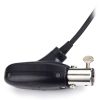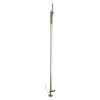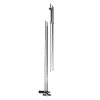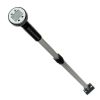OTT MF pro Flow Meter
Features
- Calculates discharge automatically based on USGS and ISO methods
- Velocity graphed in real-time on the meter's color display for trending
- Electromagnetic sensor head has no moving parts and never requires calibration
- Free ground shipping
- Expedited repair and warranty service
- Lifetime technical support
- More
Overview
The OTT MF pro saves time and resources in the field by automatically calculating discharge (based on USGS and ISO methods) and graphing velocity data in real-time, allowing trends to be visualized quickly. The rod-mounted meter with color-display captures all data, allowing measurements to be taken by one person and eliminating the need for handwritten calculations or post-measurement data correction.
Ideal for Low-Flow Environments
A small, detachable electromagnetic sensor is ideal for use in low-flow environments by eliminating the need for minimum velocity requirements. Measurements are taken directly at the sensor head rather than from a sample volume farther away. The electromagnetic sensor has no moving parts, is virtually maintenance-free, and requires no calibration, unlike mechanical meters.
Unimpeded by Organic Matter
Electromagnetic sensors are preferred for use in conditions with large amounts of organic matter as their magnetic inductive measurement principle is not affected by organic matter in the sampling area like acoustic or mechanical meters. The OTT MF Pro is lightweight and water-resistant, featuring a full-color display that is easily readable, even in bright sunlight.
Real-time Velocity
Velocity is graphed in real-time on the meter's color display, allowing trends to be visualized quickly.
Maintenance-Free
The electromagnetic sensor head has no moving parts and never requires calibration, making it virtually maintenance-free.
Versatile Applications
The sensor's magnetic inductive measurement principle makes the OTT MF pro ideal for use in low-flow conditions and environments heavy in organic matter, unlike mechanical or acoustic meters.
User-Friendly Handheld
A lightweight, water-resistant handheld features a full-color display that is easily readable even in bright sunlight.
(1) MF pro flow meter
(1) Carrying case for meter & sensor, includes shoulder strap
(1) Display mount for wading rod
(1) Velcro strap to coil cable
(1) Set of extra thumb screws
(1) USB communication cable
(1) Wall-charger and EU plug kit
(1) Lanyard
(1) Universal sensor mount
(1) Drying cloth
(1) Set of operating Instructions
In The News
Shapeshifting Rivers: The First Global River Delta Migration Database Offers Future Glimpse of the Planet’s Major Coastal Waterways
When we think of a river’s movements, we often think of its current. But rivers move in other ways too, ways that can have profound consequences to those living around them. If a river’s centerline shifts, especially if it shifts a lot, the impact can be huge, and devastating to human populations that depend on the river as a place to fish, farm, and settle. The Ganges River in India, for example, supports 650 million people who have their homes, families, and livestock gathered at its banks. As the river changes in the future due to the impact of climate and anthropogenic factors, it is of critical importance for the population living by the Ganges—or any other major river--to know what the changes will be to best prepare for a potentially radically different future.
Read MoreNew Technologies Reducing Uncertainty in Estimation of River Flow
Some of the most interesting data in the world of river and stream monitoring come at times when it's practically impossible to capture—during extreme weather events, for example. Timing alone makes capturing unusual events a challenge, and these kinds of issues have prompted researchers to use classic monitoring data along with new technologies to develop and improve hydraulic modeling for estimating river flows. Steven Lyon , a Conservation Scientist with The Nature Conservancy, Professor at Stockholm University and Associate Professor at The Ohio State University, spoke with EM about the research .
Read MoreCitizen Scientists Tracking Intermittent Rivers
Most of the time when we think of monitoring streams and rivers, we think of water, and for a good reason. However, in some parts of the country, many rivers are intermittent—dry at some point in space or time—and therefore have not had equal amounts of attention from ecologists and hydrologists. A project led by a University of Oklahoma (OU) team is working to change that with the help of citizen scientists. OU assistant professor of biology Daniel Allen spoke to EM about the project and why it's so important to track intermittent rivers. “ The Nature Conservancy (TNC) started the Citizen Science program in Arizona's San Pedro River and the nearby Cienega Creek in, I think, 2001,” details Dr. Allen.
Read More





























